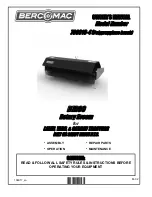
14
15
Assembly and operating manual aquagen
7149029926 V1.3 (09.2018)
Assembly and operating manual aquagen
7149029926 V1.3 (09.2018)
4 Removing the aquagen
If the aquagen has to be removed, e.g. for disposal, you have to proceed in accordance with the
instructions in this chapter.
Danger!
If the battery is supposed to be operated without the aquagen recombination system for a longer
time than necessary for maintenance purposes, the ventilation has to be shifted from the possibly
reduced air volume flow to the air volume flow required by EN 50272-2.
Danger!
In case of boost charges with high currents, the surface of the aquagen recombination system can
heat up strongly. Avoid touching the aquagen recombination system in this operating phase – risk
of injuries! Moreover, dark deposits might develop on the walls in case of boost charges. These
deposits do not impair the functionality of the aquagen recombination system.
4.1 Maintenance
Normally, the aquagen recombination system does not have to be removed from the batte-
ry cells for maintenance purposes. All current HOPPECKE lead acid battery cells in closed/
VLA design are equipped with a so-called service opening (except block batteries e. g. OGi bloc
or power.bloc OPzS), via which it is possible to measure the temperature and acid density, as
well as to refill water. Contact your local HOPPECKE representative if you need further information
about accessory products.
Before the disassembly, ensure that most of the fluid collected in the recombinator drains off downwards by
slightly knocking on the housing of the aquagen.
In order to remove the aquagen from the battery, the aquagen – together with its bayonet plugs – is loosened
by turning it counter-clockwise and then lifted off from the cell.
Figure 4: Loosening aquagen
Figure 5: Lifting off aquagen
If the bayonet plug is not directly accessible (e. g. power.bloc OPzS, OGi bloc 12V) the aquagen
recombinator can be lifted with a dedicated lifting tool Mat.-No. 7149004000.
Note:
The aquagen needs to be removed from the battery opening immediately after loosening.
Danger!
After loosening, the aquagen must be removed from the battery opening immediately.
Deposit the aquagen together with its bayonet plugs into a suitable container in order to collect electrolyte
residues.
Attention!
The aquagen must be stored in a vertical position so that remaining fluids can drain off without
obstructions, and the active material in the aquagen remains dry.
Danger!
During maintenance work, the aquagen must never be placed loosely in the (battery) cell opening!
Danger!
Always carry out cleaning work before or after the replacement using only cotton cloths (without
synthetic components) which were moistened with water.
For the subsequent assembly, please proceed according to
chap. 3.2 “Inserting the
aquagen
”
.
4.2 Disposal
Dispose of the aquagen according to
chapter 4.1
. At first, deposit the aquagen in a cardboard box with an
open top. Do not close the box! Because the aquagen might contain acid residues, the legal provisions on the
disposal which are applicable in the country of destination must be observed. Please also observe the recom-
mendations regarding disposal and handling in the safety data sheet on sulphuric acid. Please contact your
local HOPPECKE representative if you want HOPPECKE to dispose of the aquagen recombinator.
Danger!
In general, do not use plastic sacks or bags in the vicinity of the battery.





























